Chamomile flowers are easy to grow in your garden or in containers, and bring many benefits both to you and to your garden! Keep reading to learn all about how to grow, harvest and use chamomile.
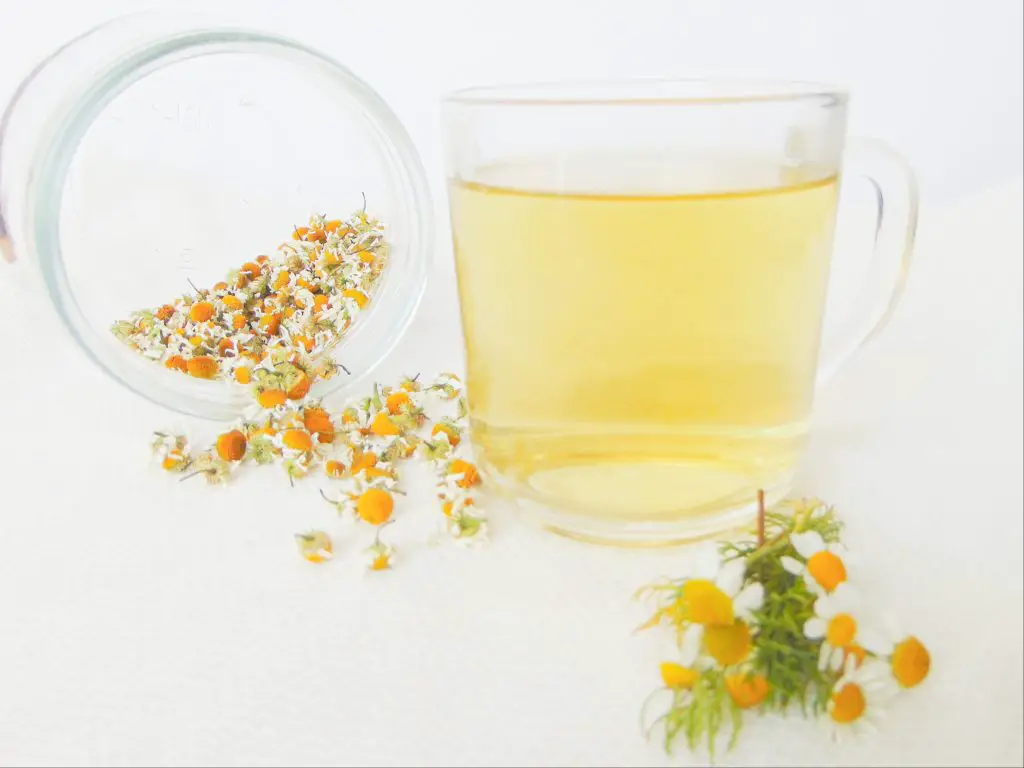
What is chamomile?
Chamomile is a herb with small flowers that look similar to daisies (they actually belong to the same plant family, the Compositae).
Chamomile is easy to grow and is one of the most popular herbal teas around the world. Chamomile flowers are very aromatic, with an apple-like fragrance.
There are two main types of chamomile:
- German chamomile: perennial plant that grows well in all zones. The plant is tall (up to 25 inches) and has fern-like stems branching into small flowers. This variety has a sweetly smoky aroma with hints of apple or pineapple.
- Roman chamomile: slow-growing perennial that grows well in zones 4-11 in partial shade. The plant is smaller (up to 12 inches), and has feathery stems with tiny yellow buds. This variety has a sweet and heady aroma with hints of apple or pineapple.
Benefits of chamomile
For your health
Chamomille has long been used as a herbal remedy and medicinal plant for a wide variety of health issues. The most common way to use chamomile is by drinking chamomile tea, which can be beneficial for:
- Reducing menstrual pain
- Lowering blood sugar
- Helping relaxation and sleep
- Treating cold symptoms
- Reducing inflammation
- Healing an upset stomach
Chamomile tea or chamomile salves can also be used to alleviate skin conditions such as dryness and redness.
Finally, chamomile essential oil (one of my favourite essential oils!) can be used in aromatherapy to promote relaxation and sleep and reduce anxiety. Chamomile essential oil can also be applied topically to help heal wounds, skin irritation, and body pains.
Safety notes
Chamomile is generally considered a safe plant, but its use is not recommended during pregnancy (as it may act as a uterine stimulant and cause miscarriages). Chamomile tea can also have a slightly laxative effect, so it’s not recommended in case you have diarrhea. Finally, chamomile can trigger allergic reactions, so always make sure you are not allergic to it before consuming large amounts.
For the garden
Chamomile is a great companion plant and attracts beneficial garden insects like ladybugs and honey bees!
In particular, chamomile is a wonderful companion plant for cabbage, cauliflower and broccoli. Growing chamomile between the plants helps control weeds and repel pests such as the cabbage moth (also known as cabbage worm).
If you’re interested in more tips about gardening on a budget, read here!
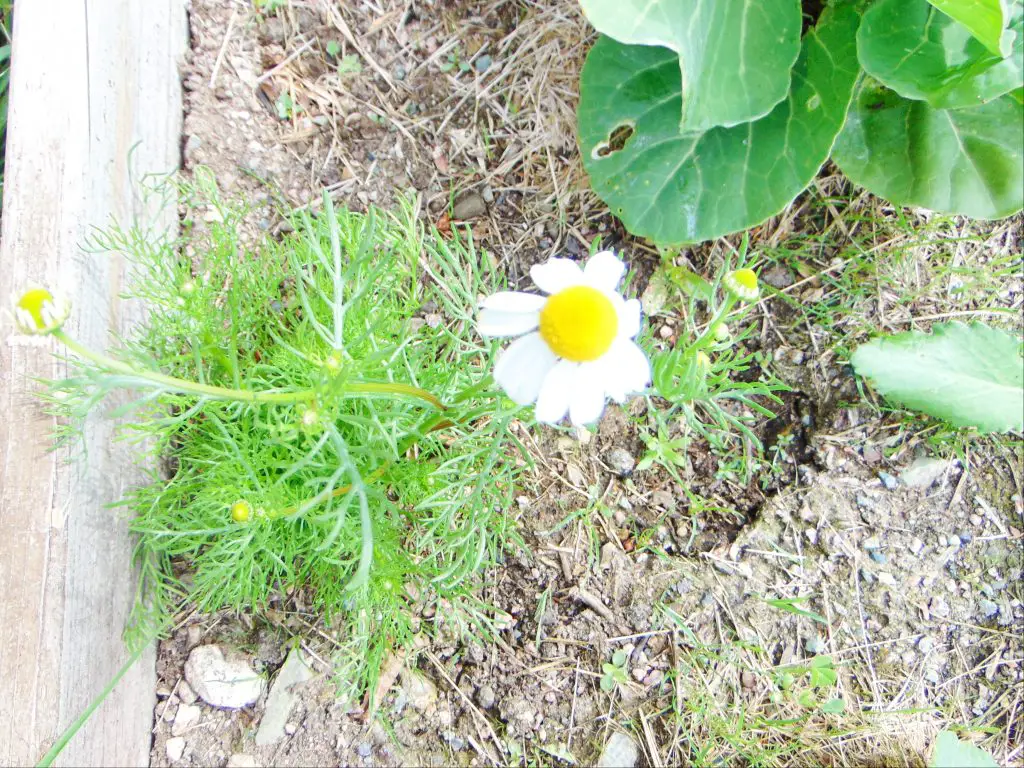
How to grow chamomile
Chamomile can be easily grown from seeds in pretty much any climate. This adaptable plant grows very well both in a garden (directly in the soil or in raised beds) or in any type of container.
Depending on where you live, you can sow chamomile seeds directly in your garden or containers outside (in early spring after the last danger of frost), or start your seeds inside and then transplant them. Because I live in a location with a very short growing season, I chose this last method to grow my chamomile. I started my seeds inside in potting soil in egg cartons. To sow chamomile seeds: sprinkle a few (very tiny) seeds on top of the soil, without burying them (they require light to germinate). Keep the soil constantly moist (mist gently) until the seeds germinate (about 10 days). If starting seeds inside, transfer outside after the danger of frost has passed and the plants are just 2-3 inches tall. Don’t forget to acclimate the seedlings first by exposing them to the outdoor elements gradually.
Chamomile grows well in full sun (at least 6 hours a day), but if you live in a very hot place, it might benefit from some afternoon shade. It grows well in average, well-drained garden soil. Chamomile doesn’t require a large amount of watering to grow well. Watering well once a week (less if it rains) should be enough. Chamomile also doesn’t require much fertilization: enrich your soil with about 1/2 inch of compost before planting and the plants should be good to grow!
Chamomile plants can grow quite big, so plant only 1 or 2 plants for each square foot of garden space.
When and how to harvest chamomile
Chamomile is typically harvested during the summer months. Harvesting chamomile can (and should) be done multiple times during the season, as the flowers are ready. Picking the flowers will also stimulate the plant to make more, increasing the yield.
The best time to harvest the chamomile blossoms is when the flowers are blooming and the petals are flat. Harvesting the blossoms a little earlier or a little later is fine but might make you lose some of the medicinal properties.
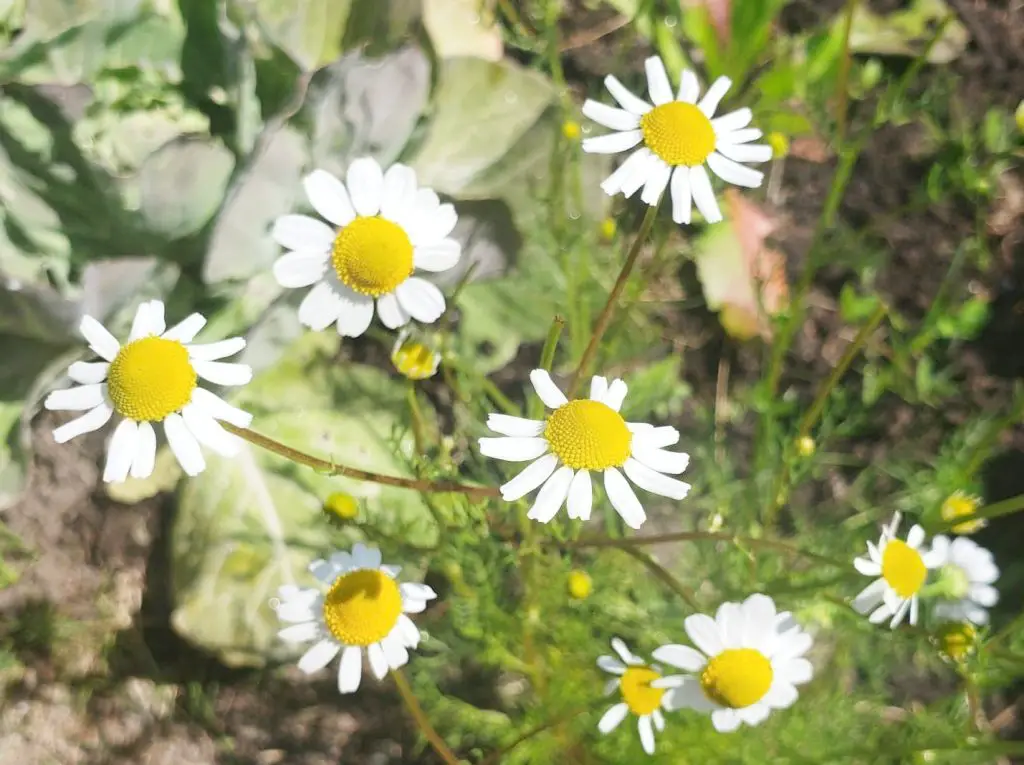
It’s best to harvest chamomile in the morning before the heat of the day starts to beat down the blossoms.
To harvest the chamomile blossoms, gently pinch the flower head off right below the base, making sure not to pull the plant.
How to dry chamomile flowers
Air-drying chamomile
This method is the easiest as it doesn’t require any equipment and it’s the method I personally use.
To air-dry chamomile flowers lay them out in a single layer on a screen or cloth. Place them in a warm, dry and well-ventilated area (away from direct sunlight) and let them dry for about 1-2 weeks, turning the flowers periodically so that all sides dry evenly.
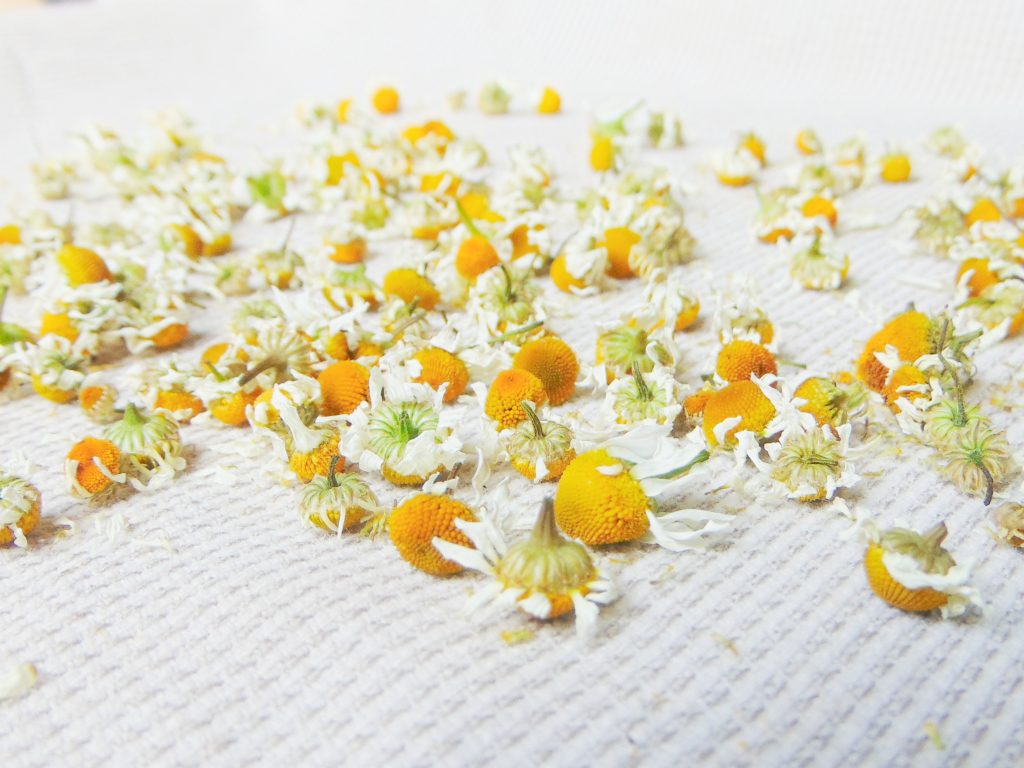
Using a food dehydrator
This is the safest and quickest method to dry chamomile flowers. Dry the flowers on the lowest temperature setting of your dehydrator. The flowers should be dry in a few hours. Check every 30 minutes or so to make sure you don’t over-dry them.
Drying chamomile in the oven
You can also dry chamomile flowers in your oven, but this might be risky, as the flowers might get ruined if the temperature gets too high! I don’t advise following this method, but if you want to try, set the oven on its lowest temperature setting (around 85 degrees F is best), spread out the flowers on a parchment-lined baking sheet, and place in the oven with the door partially open until dry. Check every 20 minutes or so to make sure they are not over-dry.
How to store dry chamomile flowers
You can store your dry chamomile flowers in an airtight container, such as a glass jar with a lid that seals. Keep the container in a cool, dry place for up to a year.
How to use chamomile flowers
The most common use of chamomile is drinking chamomile tea. To make it, add 1 teaspoon of dry chamomile to a cup and add boiling water. Let it sit for a couple of minutes and then strain (or use a tea strainer). If desired, sweeten with honey. Consume up to 4 cups of chamomile tea per day, especially before bed.
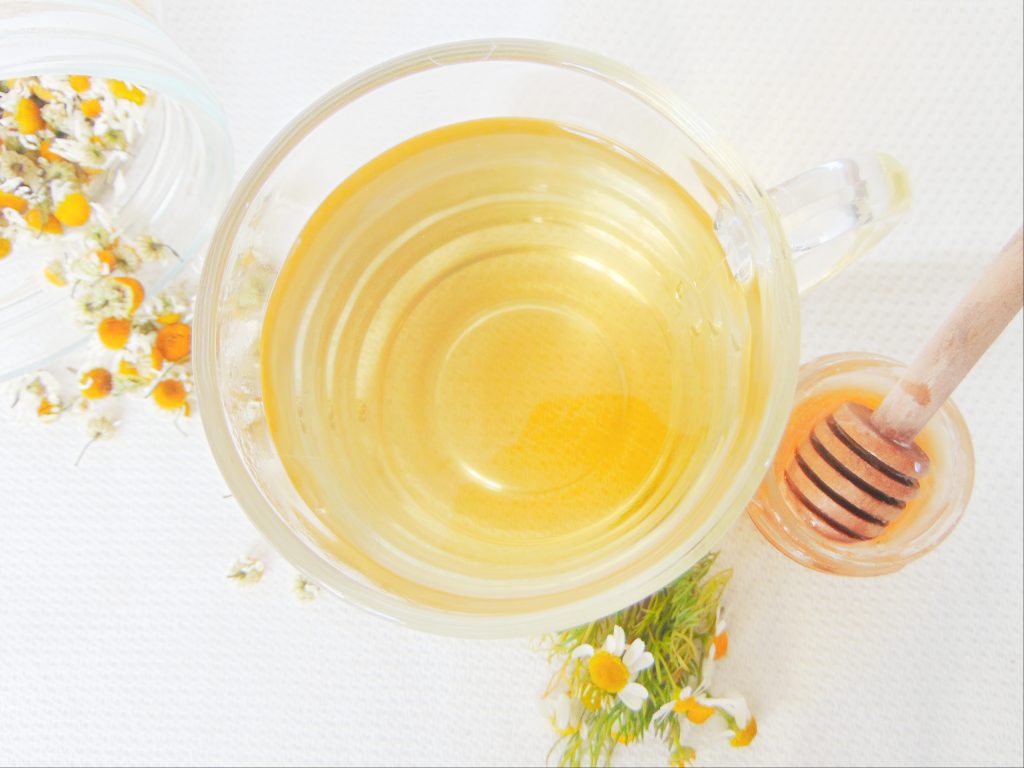
Chamomile tea can also be used as a hair lightener. To do so, make a stronger tea by adding about 1/2 cup of dry chamomile to 4 cups of boiling water. Let it sit for 10-30 minutes before straining. Apply the tea to your clean hair by dipping the hair in the tea (for about 1 minute, 4 or 5 times) or spraying the tea with a spray bottle. Massage the chamomile into your hair and let it sit for at least 1 hour before rinsing. To see a lighting effect, the treatment needs to be repeated multiple times.
You can use dry chamomile flowers to make skin salves, which are made by infusing the flowers into a carrier oil (such as coconut oil) and adding other ingredients to make a solid salve that can be applied to the skin to relieve dryness, redness and inflammation.
Related posts
Rose Water: DIY Recipe, Benefits, and Uses
How to Start a Vegetable Garden on a Budget
What is Simple Living? (And 10 tips to Simplify your Life)
Easy Tonic and Soothing Drink with Ginger, Honey, and Apple Cider Vinegar
How to Reduce your Exposure to Toxins for a Healthier Life
Pin it for later
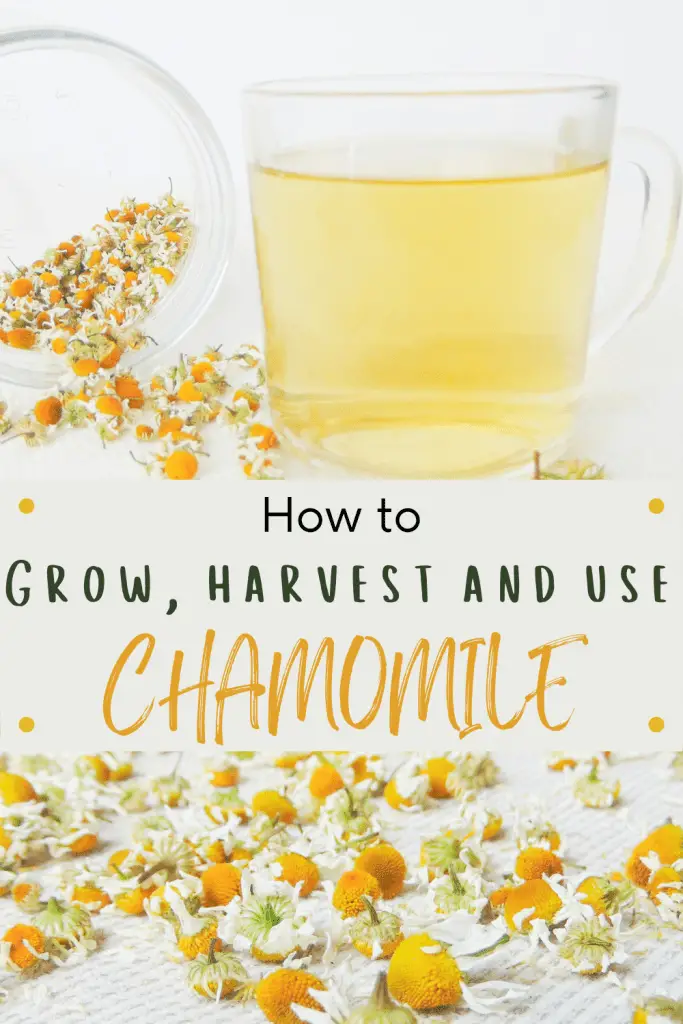


Thank you for the information! I planted some this year and was wondering how to dry it for use.
Glad this was helpful 😉
Thank You for your lovely post. Chamomile is so beautiful in the garden, but I would like to be better about using it.
Yes I agree. I think it’s a matter of getting into the habit of using it. I personally don’t buy or use much herbal teas, but growing my own makes me want to use it more. Now that I have it on hand I love making a cup of chamomile in the evening after my son goes to bed 😉